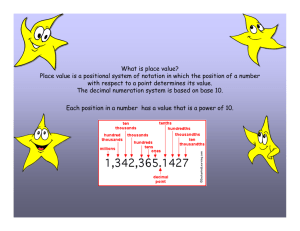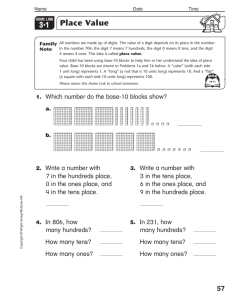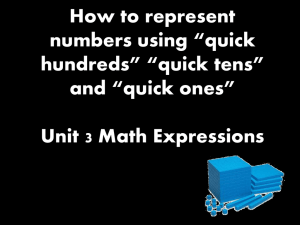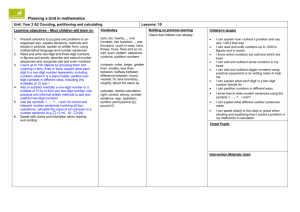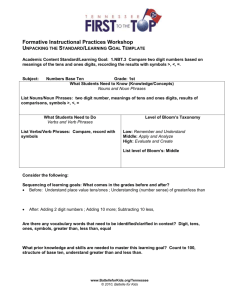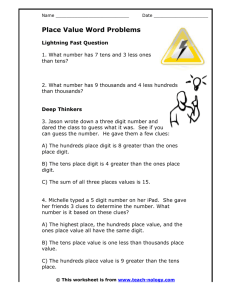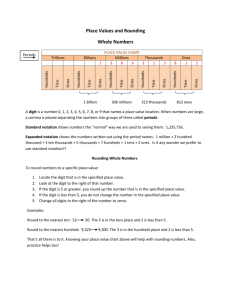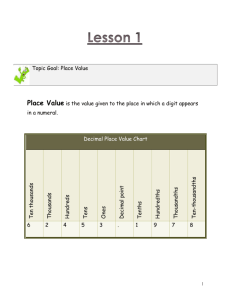Unit 2 Place value Year 2 Unit Objectives Link Objectives
advertisement
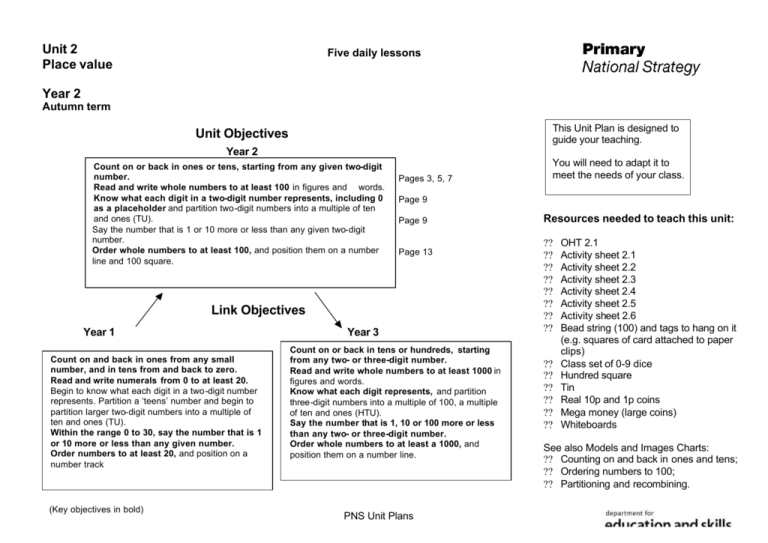
Unit 2 Place value Five daily lessons Year 2 Autumn term This Unit Plan is designed to guide your teaching. Unit Objectives Year 2 Count on or back in ones or tens, starting from any given two-digit number. Read and write whole numbers to at least 100 in figures and words. Know what each digit in a two-digit number represents, including 0 as a placeholder and partition two-digit numbers into a multiple of ten and ones (TU). Say the number that is 1 or 10 more or less than any given two-digit number. Order whole numbers to at least 100, and position them on a number line and 100 square. Pages 3, 5, 7 Page 9 Page 9 Page 13 Page 15 Link Objectives Year 1 Count on and back in ones from any small number, and in tens from and back to zero. Read and write numerals from 0 to at least 20. Begin to know what each digit in a two-digit number represents. Partition a ‘teens’ number and begin to partition larger two-digit numbers into a multiple of ten and ones (TU). Within the range 0 to 30, say the number that is 1 or 10 more or less than any given number. Order numbers to at least 20, and position on a number track (Key objectives in bold) You will need to adapt it to meet the needs of your class. Year 3 Count on or back in tens or hundreds, starting from any two- or three-digit number. Read and write whole numbers to at least 1000 in figures and words. Know what each digit represents, and partition three-digit numbers into a multiple of 100, a multiple of ten and ones (HTU). Say the number that is 1, 10 or 100 more or less than any two- or three-digit number. Order whole numbers to at least a 1000, and position them on a number line. PNS Unit Plans Resources needed to teach this unit: ?? ?? ?? ?? ?? ?? ?? ?? ?? ?? ?? ?? ?? ?? OHT 2.1 Activity sheet 2.1 Activity sheet 2.2 Activity sheet 2.3 Activity sheet 2.4 Activity sheet 2.5 Activity sheet 2.6 Bead string (100) and tags to hang on it (e.g. squares of card attached to paper clips) Class set of 0-9 dice Hundred square Tin Real 10p and 1p coins Mega money (large coins) Whiteboards See also Models and Images Charts: ?? Counting on and back in ones and tens; ?? Ordering numbers to 100; ?? Partitioning and recombining. Planning sheet Oral and Mental Objectives and Vocabulary Count on and back in ones from any given number up to 100. Day One Unit 2 Place value Main Teaching Teaching Activities Objectives and Vocabulary Ask the children to count forwards and backwards in ones from a given number e.g. 41. Stop at various numbers and change count from forwards to backwards etc. Give children a starting number e.g. 63 and ask them to count backwards silently in ones as you clap. Stop and ask: Read and write whole numbers from 0 to 100 in figures. Count in tens and begin to order numbers. Q Where will 20 beads come up? Do we need to count them in ones? Q What does this number say? Where shall we hang the tag? How did you know? Q What tag should we hang here? Why? On the board draw: 36 Q What was the biggest number you could make with the two dice? What was the smallest? Was there a number that you couldn’t make? Which numbers are not said as they are written? How do we write 19? Q Which digit is important in deciding whether the number is big or small? Discuss how they decided where numbers should go on the number line. Q Where would you put 79? Why? Which are the two closest numbers to 60? Draw the following number line on the board: Say that this line starts at zero and goes up in tens and discuss where numbers should be placed on it. VOCABULARY tens ones digit halfway between Q What does this line go up to? Where would 50 be? Why? Where should we put 10? 20? And 25? And 40? What number is halfway between 40 and 50? Where should we put 46? Will it be closer to 45 or 50? Where would we put 49? Ask other questions to help children become familiar with the marked number line. Q Where is 90? How do you know? What are the numbers in between 90 and 100? Q Which numbers are missing? Collect answers on whiteboards and discuss the children’s answers. Repeat with other intervals asking children to write the missing numbers forwards and backwards. ?? Discuss the numbers they made. Count on 6 beads after 40. Q Which number is 3 more, 4 less than our number? RESOURCES Whiteboards Q How many beads are there? Do we need to count them in ones like this, one, two, three…? Or can we count them in a quicker way? Teaching Activities/ Focus Questions Write 40 on a tag. Stop children at a particular number. Ask: 31 Use a bead string up to 50 (or use OHT 2.1) to count the beads in tens. Q What does this number say? Where shall we hang the tag? How did you know? Did you have to count the beads from the beginning? Ask the children to show their answers on their whiteboards. Continue the silent count and repeat the question. Collect answers on whiteboards and if necessary, confirm answers by counting with the class. Year Group: 2 Plenary Teaching Activities Write 25 on a tag. Ask a child to come and write 20 on a tag and hang it after the 20th bead. Q What is the next number? VOCBAULARY count on count back more less Term: Autumn Ask the children to record the numbers on their whiteboards. RESOURCES Bead string (or OHT 2.1) Whiteboards Activity sheet 2.1 (cut up to provide a number line for each child) Class set of 0-9 dice Ask for volunteers to come up and mark on 5, 15, 25… 95. Count in tens along these numbers. Ask the children to work in pairs, taking it in turns to roll two 0-9 dice. They choose which number they want to be the tens digit and which th ey want to be the ones digit. One child should try and make a small number and the other a large number. They each place the number they made on their number line (from Activity sheet 2.1) Demonstrate this first with the class. Q If you roll a 6 and a 1, what large number can you make? What small number can you make? Are 16 and 61 near to each other or far apart? If you roll a 3 and a 4, what numbers can you make? Are 34 and 43 closer or further apart than 16 and 61? PNS Unit Plans By the end of the lesson, children should be able to: ?? read and write whole numbers from 0 to 100 in figures; ?? place numbers on a number line and say which numbers are bigger or smaller. (Refer to supplement of examples, section 5, pages 5, 9 and 15.) Planning sheet Oral and Mental Objectives and Vocabulary Count on or back in ones and twos from any number up to 100. Day Two Unit 2 Place value Term: Autumn Main Teaching Teaching Activities Objectives and Vocabulary With the class, count forwards and backwards in ones from a given two-digit number. Stop at various points and ask: Read and write whole numbers from 0 to 100 in figures. Q What number is 2 more, 2 less than this number? Know what each digit in a two-digit number represents, and partition two-digit numbers into a multiple of ten and ones. Collect answers on whiteboards. Ask the class to count forwards in ones, alternating between clapping and saying the number e.g. 47, clap, 49, clap, 51 etc. Stop as the class say a number and ask: Plenary Teaching Activities Show 46 beads on the string. Point out the four groups of ten, counting them, 10, 20, 30, and 40. Say that the digit 4 tells us how many groups of ten there are in 46. Count on the 6 ones, saying 1, 2, 3, 4, 5, 6. Say that the digit 6 tells us how many ones there are. Q What did we add onto 40 to get 46? What would be left if we took away the 6 beads? What if we took away 40 beads from 46? Count on 6 from the 40, saying 41, 42, 43, 44, 45, 46. Write 46 = 40 + 6 on the board. Write 37 = 30 + ? on the board. Q What would we add onto 30 to get 37? Q What will be the next number we say? How many more is it than our present number? Demonstrate this on the bead string. Write 18 on the board. Collect answers on whiteboards and discuss the pattern of numbers. Repeat counting backwards in ones. Stop at a clap and ask: Q Collect answers on whiteboards. Discuss the pattern of numbers and repeat with the class counting forwards and backwards. VOCABULARY count on count back more less now many more? how many less? RESOURCES Whiteboards Q What does this number say? What would it look like on a bead string? What number sentence could we write to show how many tens and ones there are? What number will represent our next clap? How many less is it than the number we just clapped on? Tell class that they are to clap silently this time as they count. Start with an even number and count forwards and backwards in twos. Repeat starting with an odd number. Year Group: 2 Give out Activity sheet 2.2 and ask the children to complete the number sentences, using t he bead pictures to help them. If they finish they should make up their own tens and ones number sentences. Teaching Activities/ Focus Questions Q Which question did you find most difficult? Why? Is it easier to have the box at the beginning or the end? ?? Discuss the ‘tricky teens’ and how these are said and written. ?? Say that you are going to play ‘Guess my number’ and when the children think they have guessed the number they should write it on their whiteboards. Q My number has 2 tens and 3 ones. What is it? My number is the answer to 30 add 2. What is it? My number is 2 more than 50. What is it? My number is 39 take away 9. What’s my number? My number is 75 take away 70. What’s my number? My number is the biggest two -digit number there is. What’s my number? My number is the smallest two-digit number. What is it? By the end of the lesson, children should be able to: ?? read and write whole numbers from 0 to 100 in figures; ?? know what each digit in a two-digit number represents; ?? know, for example, that 68 is 60 + 8. VOCABULARY ones tens count on digit two-digit number sentence (Refer to supplement of examples, section 5, page 9.) RESOURCES Bead string Activity sheet 2.2 Whiteboards PNS Unit Plans Planning sheet Oral and Mental Objectives and Vocabulary Count on in ones, twos and tens from zero to 100 and back again. Day Three Unit 2 Place value Main Teaching Teaching Activities Give the children a start number and ask them to count quickly in ones, forwards and backwards. Repeat this time counting in twos, first with clapping and then without as on Day 2. Give the children an even number and count forwards in twos. Tell children that as they count they are to clap on every tens number, as they say that number. Repeat with other even starting numbers. Stop the class at 46 say and ask: Objectives and Vocabulary Partition two-digit numbers into a multiple of 10 and ones. Order numbers in the context of money. Give each pair a copy of Activity sheet 2.3 of toy jumble sale prices and Activity sheet 2.4. Demonstrate how to play ‘Spend Spend Spend’ in pairs in this way: In turn, children decide which toy to claim and cross off the correct number of 10p coins and 1p coins on the sheet. They play until they do not have enough money on the sheet to buy any more toys. They should then write how much money they have left. Discuss children’s views and confirm by counting that no tens numbers are included in the count. Tell children that you are going to drop 10p coins into a tin and you want them to listen carefully and tell you how much money is in the tin. Q How else can we say 100p? If we have 50p in the tin and drop another 10p coin in, how much will we have then? And if we add two 10p coins? VOCABULARY ones tens pennies pence coins two-digit number place value multiples Q Which toy needs the most 10p coins to pay for it? Which needs the most pennies? Collect answers and discuss strategies. Repeat counting on and back in tens from different tens numbers. RESOURCES Whiteboards Tin 10p coins Q What does this number say? How many 10p coins do you need to make this amount? How do you know? Q How many tens did you use and how many ones did you use? Q If we start with an odd number and count in twos, will we get tens numbers to clap on? Ask the children to count in tens as you drop the coins in, up to 100p. Write prices which are multiples of ten on the board e.g. 60p. Invite children to make the amounts using the Mega money 10p and 1p coins. Collect answers on whiteboards. Repeat counting forwards and backwards and discuss the positions of the tens numbers. Year Group: 2 Plenary Teaching Activities Write other two-digit prices on the board such as 21p, 35p etc. Q Which two even numbers does the number 40 lie between? VOCABULARY ones twos even odd tens Term: Autumn RESOURCES Mega money (large coins) Activity sheet 2.3 Activity sheet 2.4 PNS Unit Plans Teaching Activities/ Focus Questions ?? Invite children to show their favourite toy. Q How many tens and ones did you have to cross off to get it? Q Which is the most expensive? Which digit helps you decide this? Which is the cheapest? Which digit helps you decide? Which is more, 29p or 92p? Why? Q How much money did you have left? How did you know that you couldn’t buy anything else? Q If we could use coins other than 10p and 1p coins, which toy could we pay for using just one coin? By the end of the lesson, children should be able to: ??partition two-digit numbers into a multiple of 10 and ones; ??exchange up to 100 pennies for 10p and 1p coins; ??decide which amount of money is more or less. (Refer to supplement of examples, section 5, pages 9, 15.) Planning sheet Oral and Mental Objectives and Vocabulary Count on or back in ones, twos and tens. Day Four Unit 2 Place value Main Teaching Teaching Activities Objectives and Vocabulary On the board write the numbers: 1 Term: Autumn 2 10 Give children a start number e.g. 23. Say you want them to count forwards from 23 and you will point to the number on the board to show the steps that they are to count in. Start with ones and move to twos and tens, and then keep changing the size of the step. At this stage, keep the counting in tens to the tens numbers e.g. Know what each digit in a two-digit number represents. Plenary Teaching Activities Remind the children that when we count on in tens, we are adding 10 each time, and that when we count back in tens we are subtracting 10 time. Show this on the bead string. Say the number that is one or ten more or less than a given two -digit number. Slide another 10 beads along the string to join the 23. Q How many beads do we have now? How do we write that number? How many groups of ten? How many ones? Which digit has changed? Which digit would change if we added another 10? Another 1? 23, 24, 25, 26, 28, 30, 40, 50, 52, 54, 55 etc. Repeat with different starting numbers, and ask children to count backwards. Ascertain that adding 10 changes the tens digit only. Adding 1 usually only changes the ones digit. Remind children that they have been counting in tens, using only the tens numbers. Q Can you think of a number that changes both its tens digit and ones digit when you add one to it? What is the ones digit? Q If we counted on from 23 in tens, what would the next two numbers be? Agree that this will happen if the ones digit is 9. Ask a child to find 23 on the hundred square. Collect answers on whiteboards and discuss patterns in the digits. Repeat with other starting numbers. Include different units digits e.g. 42, 69 and ask children to count forwards and backwards in tens. Q Q Tell the children that you want them to count in ones, twos and tens forwards and backwards. Explain that you will point to the number on the board as before, this time saying forwards or backwards to identify the direction of the count. Give children a start number e.g. 55 and generate a count such as: 55, 56, 57, 67, 77, 76, 75, 74, 72, 70. Include counting in tens from a variety of two-digit numbers. Start slowly but encourage the children to build up speed gradually as they become more confident. RESOURCES Class hundred square What is 23 + 10? Where is the answer on the hundred square? What is 23 + 1? Where is the answer on the hundred square? Teaching Activities/ Focus Questions ?? Discuss the effect of a dding subtracting 1 and 10. Q When you added 1, which number changed both its digits? Why? Which number changed both its digits when you subtracted 1? Why? ?? Say that a chocolate bar costs 32p. Q If the price increases by 1p, what will the new price be? If it increased by 10p what would the new price be? If the new price was 1p less, what would it be? If it was 10p less what would it be? HOMEWORK – Give out Activity sheet 2.5, read through the instructions and ask the children to play the game with someone at home. Show 45 beads on the bead string. Slide 10 beads back to leave 35 beads. Refer to a displayed hundred square. Point to numbers on the square as they count in tens to help the children see and use the patterns. VOCABULARY count on count back ones twos tens Year Group: 2 What has happened this time? How many beads are left? Which digit has changed? Which digit would change if we subtracted another 10 beads? What if we subtracted one bead? When would both digits change? Agree that both digits would change when subtracting one from a number ending in zero. VOCABULARY groups of ten ones tens digit add subtract Ask a child to find 35 on the hundred square. Q What is 35 – 10? Where is the answer on the hundred square? What is 35 – 1? Where is the answer on the hundred square? Write the following two -digit numbers on the board: 42, 75, 84, 61, 79, 50, 30. RESOURCES Bead string Class hundred square Activity Sheet 2.5 Ask the children to choose at least four numbers. They should add and subtract 1, and then add and subtract 10 to and from each of their four numbers recording the number sentences like this: e.g. 42 + 1 = 43 42 + 10 = 52 42 – 1 = 41 42 – 10 = 32 PNS Unit Plans By the end of the lesson, children should be able to: ?? recognise what each digit in a two-digit number represents; ?? respond to questions such as, ‘what is 1 more than 53? What is 10 less than 78?’ (Refer to supplement of examples, section 5, pages 9, 13.) Planning sheet Oral and Mental Objectives and Vocabulary Counting in ones, twos and tens. Day Five Unit 2 Place value Term: Autumn Main Teaching Teaching Activities Write on the board: 1 2 Objectives and Vocabulary 10 Ask class to count forwards and backwards as on day 4 in steps of 1, 2 and 10. Have a hundred square displayed as before. Say the number that is one or ten more or less than a given two-digit number. Position numbers on a hundred square. At various points stop the count e.g. 44 and ask: Year Group: 2 Plenary Teaching Activities Say that you are thinking of a number on the hundred square. Make sure that all the children can see the hundred square. Teaching Activities/ Focus Questions ?? Draw the following shape on the board: Q When you add 1 to this number the answer is 36. When you take away 1 the answer is 34. When you add 10 to my number you get 45. When you subtract 10 from my number you get 25. What’s my number? 35 Repeat with other two-digit numbers, asking children to secretly write down the number in their books when they’ve guessed it. Draw a cross shape on the board (like the one on the sheet with 46 in the centre) and write 35 in the middle. Q What number will we get if we count on two 10s and a 2? Q If this were part of hundred square, what number would go after 35 to the right? How do we work that out? What number would come before it? Above it? Below it? How do we work out what these missing numbers are? Collect answers on whiteboards and discuss children’s solutions and strategies. Repeat counting from different starting points and asking similar questions. Include both forwards and backwards counts. Stop at various numbers e.g. 61 and ask questions such as: Give out Activity sheet 2.6: segments from a hundred square. Ask children to complete as many of the pieces as possible without looking at a hundred square. Q What numbers might go in the other boxes? How could we work them out? ?? Discuss each square in turn, and what needs to be added/subtracted, e.g. adding 10 and 1 produces the number in the bottom right-hand corner. ?? Draw the calculations on a number line, e.g. +10 +1 Q What number will we get if we count backwards three 10s and forw ards 2? 35 45 +10 or 46 +1 VOCABULARY ones twos tens forwards backwards RESOURCES Class hundred square Tell the children that this time you want them to count without the help of the hundred square. Hide the square and get the class to count, stop and ask questions as before and encourage them to imagine the hundred square if it helps them. 35 46 56 By the end of the lesson, children should be able to: VOCABULARY ones tens hundreds two-digit number more less ?? use their knowledge of adding/subtracting 1 or 10 to fill in missing numbers on a hundred square. (Refer to supplement of examples, section 5, pages 13, 15). RESOURCES Class hundred square Activity sheet 2.6 PNS Unit Plans


